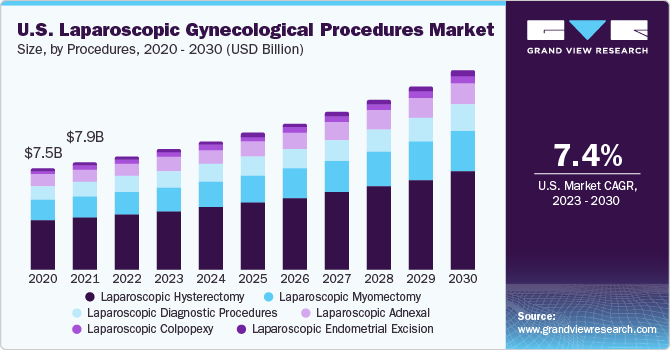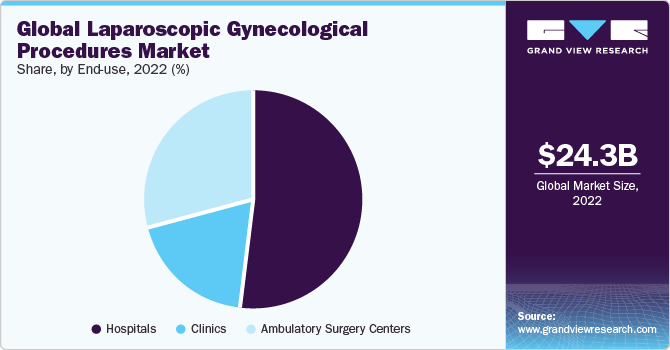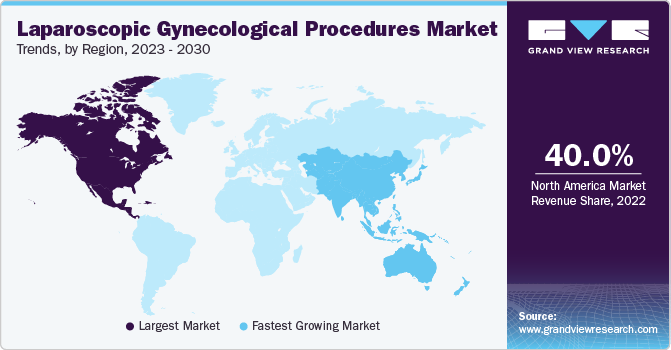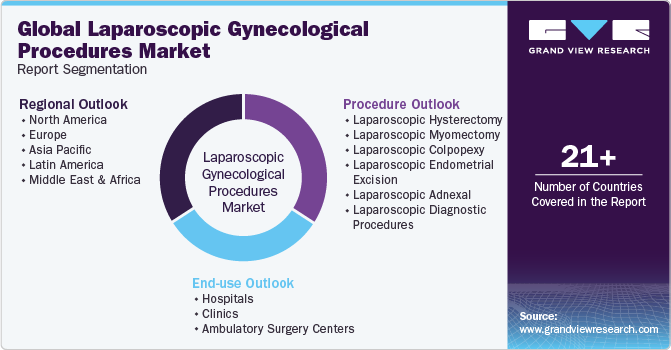- Home
- »
- Medical Devices
- »
-
Laparoscopic Gynecological Procedures Market Report, 2030GVR Report cover
![Laparoscopic Gynecological Procedures Market Size, Share & Trends Report]()
Laparoscopic Gynecological Procedures Market Size, Share & Trends Analysis Report By Procedure (Laparoscopic Hysterectomy, Laparoscopic Myomectomy), By End-use (ASCs, Hospitals), By Region, And Segment Forecasts, 2023 - 2030
- Report ID: GVR-4-68039-486-6
- Number of Report Pages: 90
- Format: PDF, Horizon Databook
- Historical Range: 2018 - 2021
- Forecast Period: 2023 - 2030
- Industry: Healthcare
Market Size & Trends
The global laparoscopic gynecological procedures market size was valued at USD 24.3 billion in 2022 and is expected to grow at a compound annual growth rate (CAGR) of 7.4% from 2023 to 2030. Increasing adoption of minimally invasive surgeries, growing prevalence of gynecological disorders, and surgery-related technological advancements are driving the market growth. In addition, the COVID-19 pandemic has majorly impacted the market as surgeries were often being postponed or even canceled to curb the spread of the virus. Elective surgeries were limited, however, situations necessitating urgent gynecological or obstetric surgeries were being conducted.

The American Association of Gynecologic Laparoscopists (AAGL), European Society of Gynaecological Endoscopy (ESGE), Royal College of Obstetricians & Gynaecologists (RCOG), and Society of American Gastrointestinal and Endoscopic Surgeons (SAGES) stated that elective surgical procedures for benign diseases must be postponed, prioritizing emergency surgeries. This will enable the utilization of key resources in obligatory areas.
The increasing prevalence of gynecological disorders, such as abnormal vaginal bleeding, Uterine Fibroids (UF), cervical cancer, ovarian cysts, endometriosis, and other related disorders, is driving the market growth. According to World Health Organization (WHO), in 2020, there were 6,04,000 new cases of cervical cancer and it caused around 3,42,000 deaths making it the fourth most common cancer in women. UF is one of the most common gynecological disorders. It is a benign tumor of smooth muscle cells formed in the woman’s uterus, which can lead to pelvic pain, extreme menstrual bleeding, infertility, and frequent urination. According to the Society for Women’s Health Research in November 2021, approximately 26 million women in the U.S. aged between 15 to 50 have UF. Similarly, as per the research article published in Dove Press Ltd., prevalence estimations of uterine fibroid disease varied, ranging from 5.4% to 23.6%, depending on the age group. Moreover, according to the Office on Women’s Health of the U.S., fibroids are developed in near about 20% to 80% of women by the age of 50. Such a high target patient pool leads to an increase in demand for laparoscopic procedures.
Uterine cancer is one of the most prevalent gynecological disorders globally and its prevalence is rising at an exponential rate. This upsurge has commonly been driven by the rise in obesity cases. For instance, according to the American Cancer Society, Inc., the new uterine cancer cases in 2023 are expected to reach around, 66,200 in the U.S. Moreover, the Canadian Cancer Society estimated nearly 8,100 women in Canada were projected to be diagnosed with uterine cancer in 2022. Furthermore, according to Patient UK in December 2021, approximately 8,600 new cases of endometrial cancer are registered in the UK, which is the common type of uterine cancer. Therefore, the increasing incidence of uterine cancer has led to an increasing number of laparoscopic procedures, thereby accelerating market growth.
Nowadays, minimally invasive surgical procedures are being increasingly adopted due to lower trauma associated with them. Small incisions decrease postoperative pain and facilitate speedy recovery, leading to high adoption of these procedures, which is driving R&D in this field. In addition, minimally invasive laparoscopic surgeries are being covered by health insurance providers in selected countries. For instance, Medicare now covers up to 75% of laparoscopic operations, as listed in the Medicare Benefits Schedule (MBS). These factors have led to increased preference for minimally invasive surgeries by patients.
Furthermore, single-site incisional surgery is being widely used in laparoscopic procedures and is replacing traditional procedures, in which four to five small incisions were made as the entry point for laparoscopic instruments. Some of the key benefits of a single-site incision laparoscopic procedure are low chances of infections, better cosmetic results, quick recovery, and less post-operative pain. As per the Journal of the Society of Laparoendoscopic Surgeons (JSLS), women who underwent single-site incision laparoscopic surgery tend to report less postoperative pain compared to the ones who underwent the traditional procedure. Thus, the growing demand for single-incision laparoscopic surgery would boost the market growth over the forecast period.
The rising prevalence of colorectal cancer is another key factor driving the market growth. Colorectal cancer has majorly been diagnosed in people who consume low-fiber food, which mostly includes animal protein, fat, and refined carbohydrates. Increased risk of colorectal and urinary bladder cancers has raised the demand for colorectal surgeries. According to a study published in NCBI, colorectal cancer is the fourth most common cancer and the second main cause of cancer-related deaths in the U.S. Moreover, according to the American Cancer Society (ACS), in 2023 the number of new colorectal cancer cases are estimated to reach 1,53,020 in the U.S. with 1,06,970 new colon cancer and 46,050 new rectal cancer cases.
The risk of colorectal cancer increases with age, as it is commonly diagnosed in people aged 65 to 74 years. As per the WHO, the global geriatric population (aged 60 or above) was around 1 billion, which is estimated to reach 1.4 billion by 2030 and a further 2.1 billion by 2050. According to the American Society of Nephrology, urologic disorders are the third most common concern amongst the elderly population, and these account for about 47% of the physician visits. Thus, the rising geriatric population is also likely to be a major factor driving the market over the forecast period.
End-use Insights
The hospitals segment held the largest revenue share of over 55% in 2022. Hospitals offer superior care to patients and provide reimbursements for certain procedures, which are further contributing to the segment growth. Furthermore, hospitals are currently advancing in terms of technology. Technologically advanced devices are being used extensively in hospitals to provide better treatment. These devices are not only simplifying treatment procedures but also providing better, faster, and accurate results.
Hospitals also witness a significantly high inflow of patients for laparoscopic procedures as compared to other healthcare settings, owing to ease of handling any emergencies that may arise during surgical procedures and availability of a broad range of treatment options. Thus, the aforementioned factors are expected to drive the growth of the hospitals segment.

On the basis of end use, the market has been segmented into hospitals, clinics, Ambulatory Surgery Centers (ASCs), and others. The growth of the hospitals segment can mainly be attributed to an increase in the number of patients suffering from various chronic ailments and a consequent rise in surgical procedures.
The ASCs segment is expected to grow at the fastest CAGR of 7.7% over the forecast period. High preference for outpatient surgeries, increase in the adoption of minimally invasive surgeries, and cost-effectiveness of ASC-based laparoscopic procedures are key factors responsible for the lucrative growth of this segment. Lower postsurgical complications in minimally invasive laparoscopic surgery are expected to increase the demand for ASCs as they offer several advantages to patients, including shorter procedure time and same-day discharge. Most intra-abdominal procedures can now be performed laparoscopically at ambulatory surgery centers, as these are less invasive. Surgeries at ambulatory surgery centers not only have shorter stay duration but are also more affordable than inpatient operations, which reduces patient expenditure. These factors are projected to boost the segment growth during the forecast period.
Procedure Insights
In 2022, the laparoscopic hysterectomy segment dominated the market accounting for the largest revenue share of over 45%. On the basis of procedures, the market has been segmented into laparoscopic hysterectomy, laparoscopic myomectomy, laparoscopic colpopexy (sacrocolpopexy, sacrocervicopexy, etc.), laparoscopic endometrial excision, laparoscopic adnexal (oophorectomy, salpingo-oophorectomy, etc.), laparoscopic diagnostic procedures (requiring chromopertubation).
Laparoscopic hysterectomy is one of the widely used minimally invasive procedures for removing the uterus. This procedure has several advantages, such as the low risk of blood loss & infection and reduced hospital stays. Moreover, the risks of getting complications post-surgery are comparatively low. In addition, this procedure is inexpensive compared to a robotic hysterectomy. Thus, the aforementioned advantages drive its adoption, in turn, boosting the segment growth. According to Medscape in April 2023, robotic-assisted laparoscopic hysterectomy had 65.8% of total hysterectomies surgeries and it has become the most common surgical approach in the past 30 years.
The laparoscopic myomectomy segment is anticipated to grow at the fastest CAGR of 7.6% over the forecast period. It is an inexpensive and safe procedure for removing fibroids from the uterus and advantageous as compared to other treatments. It results in less blood loss, shorter hospitalization, and rapid postoperative recovery. It also offers a decreased risk of postoperative pain and lower incidence of ileus & thrombo-embolic phenomenon. Over the past two decades, laparoscopic myomectomy has gained popularity as an alternative to conventional laparotomy.
However, this procedure is currently challenging in minimally invasive surgery that necessitates a well-trained surgical team, appropriate instrumentation, and careful patient selection. Nevertheless, the increasing inclination of gynecologists toward laparoscopic techniques, and advancements in surgical instrumentation and suturing materials might help keep laparoscopic myomectomy from being restricted to tertiary care. Furthermore, technological advances, such as the increased use of robotic and laparoscopic-assisted surgery to provide quality and effective care, will add to the segment expansion in the forecast period.
Regional Insights
North America dominated the global market for laparoscopic gynecological procedures accounting for the share revenue share of around 40% in 2022 owing to the presence of well-established healthcare infrastructure, availability of skilled surgeons, and launch of technologically advanced products by the key market players. Growing awareness about the benefits of minimally invasive surgeries and laparoscopic procedures will drive the market growth over the forecast years. In addition, increasing healthcare expenditure in the U.S. may also favor the entry of both new and old players.

For instance, according to the Center for Medicare & Medicaid Services (CMS) of the U.S. government, national healthcare expenditure of the U.S. rose by 2.7% in 2021 to reach USD 4.3 trillion, which accounts for 18.3% of the U.S. Gross Domestic Product (GDP). Moreover, the National Health spending is expected to grow at an annual rate of 5.4% from 2022 to 2031 by outpacing the average GDP growth of 4.6% to reach an expenditure of 19.6% of GDP by 2031. Furthermore, several government and non-government bodies increased their funding in healthcare sectors to support innovations and technological advancements in surgeries & other fields. For instance, healthcare finance by local and state governments had increased to 4.1% in 2017 from 3.8% in 2016. These factors indicate that the U.S. market would exhibit considerable growth over the forecast period.
Asia Pacific is expected to witness the fastest CAGR of 7.7% over the forecast period. The market in Asia Pacific is majorly driven by China, Japan, India, Singapore, and Australia. The market in China is driven by a rise in disposable income levels and a fast-growing geriatric population. According to the China Population and Development Research Center, approximately 350.0 million people in China will be above the age of 65 years by 2050. Similarly, as per the WHO, by 2040, 402 million people in China, which accounts for about 28% of the total population of the country, will be over the age of 60 years. Other driving factors include affordable devices, an increase in mergers & acquisitions, and government initiatives to improve healthcare services. The government in the country has made significant investments to provide basic health insurance to all its citizens.
Key Companies & Market Share Insights
Key players are involved in adopting strategies, such as mergers & acquisitions, partnerships, and new products launches, to strengthen their foothold in the global market. For instance, In December 2021, Medtronic Canada ULC, a subsidiary of Medtronic plc announced that its robotic-assisted surgery (RAS)system Hugoreceived Health Canada approval for use in gynecologic laparoscopic and urological surgeries. This approval is expected to bring robotic surgery benefit to the patients. In June 2021, Ethicon introduced ENSEAL X1 Curved Jaw Tissue Sealer, the newest, latest, and advanced laparoscopic bipolar energy device that provides stronger sealing, with better grip to tissues, and improves procedural efficiency. It is indicated for bariatric surgery, gynecological, thoracic, and colorectal procedures. In February 2020, Medtronic acquired Digital Surgery, a medical device company and innovator in surgical Artificial Intelligence (AI), digital education, training, & data analytics. This acquisition will enhance its robotic-assisted surgery platform and provide AI & data analytics within laparoscopic procedures.
Key Laparoscopic Gynecological Procedures Companies:
- Medtronic
- Stryker
- Karl Storz SE & CO. Kg
- Johnson and Johnson
- Olympus Corporation
- CONMED Corporation
- B. Braun SE
- The Cooper Companies, Inc.
- Richard Wolf GmbH
- Microline Surgical
- Welfare Medical Ltd.
- Intuitive Surgical
- Shenzhen Mindray Bio Medical Electronics Co., Ltd.
Laparoscopic Gynecological Procedures Market Report Scope
Report Attribute
Details
Market size value in 2023
USD 25.75 billion
Revenue forecast in 2030
USD 42.3 billion
Growth rate
CAGR of 7.4% from 2023 to 2030
Base year for estimation
2022
Historical data
2018 - 2021
Forecast period
2023 - 2030
Report updated
December 2023
Quantitative units
Revenue in USD million/billion, and CAGR from 2023 to 2030
Report coverage
Revenue forecast, company ranking, competitive landscape, growth factors, and trends
Segments covered
Procedure, end-use, region
Regional scope
North America; Europe; Asia Pacific; Latin America; Middle East & Africa (MEA)
Country scope
U.S.; Canada; UK; Germany; France; Italy; Spain; Denmark; Sweden; Norway; Japan; China; India; Australia; South Korea; Thailand; Brazil; Mexico; Argentina; Saudi Arabia; South Africa; UAE; Kuwait;
Key companies profiled
Medtronic; Stryker; Karl Storz SE & CO. Kg; Johnson and Johnson; Olympus Corporation; CONMED Corporation; B. Braun SE; The Cooper Companies, Inc.; Richard Wolf GmbH; Microline Surgical; Welfare Medical Ltd.; Intuitive Surgical; Shenzhen Mindray Bio Medical Electronics Co., Ltd.
Customization scope
Free report customization (equivalent up to 8 analysts working days) with purchase. Addition or alteration to country, regional & segment scope.
Pricing and purchase options
Avail customized purchase options to meet your exact research needs. Explore purchase options
Global Laparoscopic Gynecological Procedures Market Report Segmentation
This report forecasts revenue growth at global, regional, and country levels and provides an analysis of the latest industry trends in each of the sub-segments from 2018 to 2030. For the purpose of this study, Grand View Research has segmented the global laparoscopic gynecological procedures market report on the basis of procedure, end-use, and region:

-
Procedure Outlook (Revenue, USD Million, 2018 - 2030)
-
Laparoscopic Hysterectomy
-
Laparoscopic Myomectomy
-
Laparoscopic Colpopexy (Sacrocolpopexy, Sacrocervicopexy, etc.)
-
Laparoscopic Endometrial Excision
-
Laparoscopic Adnexal (Oophorectomy, SalpingoOophorectomy, etc.)
-
Laparoscopic Diagnostic Procedures (Requiring Chromopertubation)
-
-
End-use Outlook (Revenue, USD Million, 2018 - 2030)
-
Hospitals
-
Clinics
-
Ambulatory Surgery Centers (ASCs)
-
-
Regional Outlook (Revenue, USD Million, 2018 - 2030)
-
North America
-
U.S.
-
Canada
-
-
Europe
-
UK
-
Germany
-
France
-
Italy
-
Spain
-
Norway
-
Sweden
-
Russia
-
-
Asia Pacific
-
Japan
-
China
-
India
-
Australia
-
South Korea
-
Thailand
-
-
Latin America
-
Brazil
-
Mexico
-
Argentina
-
-
MEA
-
South Africa
-
Saudi Arabia
-
UAE
-
Kuwait
-
-
Frequently Asked Questions About This Report
b. The global laparoscopic gynecological procedures market size was estimated at USD 24.3 billion in 2022 and is expected to reach USD 25.75 billion in 2023.
b. The global laparoscopic gynecological procedures market is expected to grow at a compound annual growth rate of 7.4% from 2023 to 2030 to reach USD 42.3 billion by 2030.
b. North America dominated the laparoscopic gynecological procedures market with a share of 40.0% in 2022. This is attributable to the presence of the key market players, to increasing reliance on laparoscopic surgeries over open surgeries, and increasing awareness about the benefits of minimally invasive surgeries.
b. Some of the key players operating in the laparoscopic gynecological procedures market include Karl Storz SE & CO. Kg, Johnson and Johnson, Olympus Corporation, CONMED Corporation, B. Braun Melsungen AG, The Cooper Companies Inc., Richard Wolf GmbH, Microline Surgical, BD, Welfare Medical Ltd., DEAM, Intuitive Surgical and Shenzen Mindray Bio Medical Electronics Co., Ltd.
b. Key factors that are driving the laparoscopic gynecological procedures market growth include the Increasing adoption of minimally invasive surgeries over traditional methods, the increasing prevalence of colorectal cancer, and other surgery-related technological advancements.
Share this report with your colleague or friend.
![gvr icn]()
NEED A CUSTOM REPORT?
We can customize every report - free of charge - including purchasing stand-alone sections or country-level reports, as well as offer affordable discounts for start-ups & universities. Contact us now
![Certified Icon]()
We are GDPR and CCPA compliant! Your transaction & personal information is safe and secure. For more details, please read our privacy policy.
We are committed towards customer satisfaction, and quality service.
"The quality of research they have done for us has been excellent."





